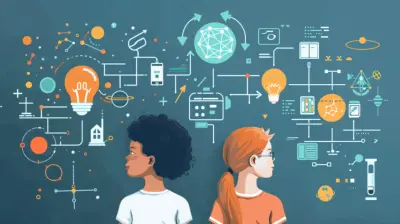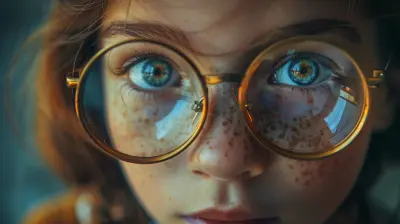The Power of Cross-Disciplinary Learning in STEM
24 November 2024
In today’s fast-evolving world, education is not just about mastering a single subject. It’s about understanding how different domains connect and intertwine, creating a richer, more practical learning experience. When it comes to STEM (Science, Technology, Engineering, and Mathematics), cross-disciplinary learning is not just a bonus — it’s essential.
But what exactly is cross-disciplinary learning, and why is it so important in STEM fields? Let’s dive deep into this concept and explore how it can shape the innovators of tomorrow.
What Is Cross-Disciplinary Learning?
Cross-disciplinary learning is where different fields of study intersect and collaborate. Think of it as a weaving together of knowledge threads from various subjects to create a more comprehensive understanding of a topic. It’s like cooking a dish with multiple ingredients: each component brings its unique flavor, but it’s the combination that creates something truly delicious.In a traditional educational setting, students often focus on one subject at a time, compartmentalizing knowledge. But in real life, problems don’t come neatly packaged. They are complex and multifaceted, demanding solutions that pull from various areas of expertise.
For example, to design a sustainable energy solution, you might need to understand physics (the science behind energy transformation), engineering (how to build efficient systems), mathematics (to calculate energy outputs), and even economics (to ensure the solution is cost-effective). That’s the magic of cross-disciplinary learning – it mirrors the interconnectedness of the real world.
Why Cross-Disciplinary Learning is Critical in STEM
1. Real-World Problem Solving
Let's be honest, the problems we face in the real world aren't siloed into neat categories like "Physics" or "Math." They are usually messy, multi-dimensional, and require a range of skills and knowledge to solve. Cross-disciplinary learning mirrors this complexity, preparing students not just to solve textbook problems but to tackle real-world challenges head-on.Take climate change, for instance. Addressing this global issue requires knowledge of environmental science, chemistry, political science, economics, and even psychology. Cross-disciplinary STEM education trains students to think holistically and approach problems from multiple angles, helping them become more versatile problem solvers.
2. Fosters Innovation
Innovation often happens at the intersection of different disciplines. When you bring together diverse perspectives, you’re more likely to develop creative solutions. It’s like cross-pollination — instead of sticking to a single idea, you mix and match concepts from different fields, leading to unexpected breakthroughs.Consider the smartphone in your pocket. It’s not just a product of engineering. It’s the result of combining advancements in software development, electrical engineering, materials science, and even design principles from the arts. Without cross-disciplinary collaboration, this kind of innovation wouldn’t be possible.
3. Prepares for Future Careers
It’s no secret that the job market is evolving. Many of the jobs that exist today didn’t even exist a decade ago, and the roles of the future will demand even more versatility. Employers are looking for people who can think across disciplines, adapt to new challenges, and bring a wide range of skills to the table.By embracing cross-disciplinary learning, students can future-proof their careers. They’ll be better equipped to work in dynamic, interdisciplinary teams, where the ability to see connections between fields is just as important as deep expertise in one area.
4. Encourages Lifelong Learning
The world is constantly changing, and the skills that are relevant today might not be relevant tomorrow. Cross-disciplinary learning fosters curiosity and adaptability, encouraging students to become lifelong learners. When you’re used to drawing from multiple areas of knowledge, it becomes easier to pick up new skills, think critically, and stay flexible in a rapidly changing world.
How STEM Education Can Embrace Cross-Disciplinary Learning
Now that we understand the power of cross-disciplinary learning, the next question is: how can we integrate it into STEM education?1. Project-Based Learning
One of the best ways to encourage cross-disciplinary learning is through projects that require students to apply knowledge from multiple fields. Instead of focusing solely on exams or theoretical knowledge, students can work on hands-on projects that mirror real-world challenges.For example, a robotics project might require knowledge of computer science (coding the robot), mechanical engineering (building the robot), and physics (understanding the robot’s movements). By working on such projects, students can see how different disciplines come together to create a tangible solution.
2. Collaborative Learning Environments
Collaboration is key to cross-disciplinary learning. When students from different backgrounds and skill sets come together, they can share ideas, learn from each other, and develop a more holistic understanding of a problem.In a collaborative learning environment, a computer science student might team up with an engineering student to design a new app, or a biology major might work with a mathematician to model the spread of a disease. These collaborations can lead to deeper learning and more innovative solutions.
3. Encouraging Curiosity Across Subjects
Teachers play a critical role in fostering cross-disciplinary learning by encouraging curiosity across subjects. Instead of treating each subject as a standalone entity, educators can highlight the connections between different fields.For instance, while teaching a math class, a teacher might show how mathematical concepts are used in physics or engineering. Or in a science class, they might draw connections to technology and how it’s being used to solve scientific problems. By showing these overlaps, educators can help students see the bigger picture and understand how knowledge from different subjects can work together.
Examples of Cross-Disciplinary Learning in STEM
To further illustrate how powerful cross-disciplinary learning can be, let’s look at a few examples where the blending of disciplines has led to remarkable innovations.1. Biomedical Engineering
Biomedical engineering is a perfect example of cross-disciplinary learning in action. It’s a field that combines knowledge from biology, medicine, engineering, and even computer science to develop medical devices and technologies that save lives.Think about the development of artificial organs, prosthetics, or medical imaging devices like MRI machines. These innovations require an understanding of human biology and the application of engineering principles, along with knowledge of materials science and computer algorithms. It’s the intersection of multiple disciplines that makes these life-saving technologies possible.
2. Environmental Science and Engineering
Another excellent example is the intersection of environmental science and engineering. To create sustainable solutions for issues like water pollution, climate change, and renewable energy, professionals need to draw from a wide range of disciplines.For instance, designing a solar power plant requires an understanding of physics (how solar energy is converted into electricity), engineering (how to build the plant), and environmental science (how the plant will impact the surrounding ecosystem). Cross-disciplinary collaboration is essential for creating solutions that are both effective and sustainable.
3. Data Science
Data science is a field that sits at the crossroads of mathematics, statistics, computer science, and domain-specific knowledge (like healthcare, finance, or marketing). Data scientists analyze massive amounts of data to find patterns and insights that can drive decision-making and innovation.For example, in healthcare, data science can be used to analyze patient data and develop predictive models for disease outbreaks. This requires not only a deep understanding of statistics and machine learning algorithms but also knowledge of the medical field to make sense of the data. It’s a true example of how cross-disciplinary knowledge can lead to groundbreaking discoveries.
The Challenges of Cross-Disciplinary Learning
While the benefits of cross-disciplinary learning are clear, it’s not without its challenges. Integrating different disciplines can be difficult, especially in educational systems that are often designed to keep subjects separate.1. Overcoming Silos in Education
One of the biggest challenges is overcoming the traditional silos in education. Many schools and universities are still organized in a way that separates subjects, making it difficult for students to see the connections between them. However, institutions that are forward-thinking are beginning to break down these barriers by offering interdisciplinary courses and encouraging project-based learning.2. Teacher Training
Another challenge is ensuring that educators are equipped to teach in a cross-disciplinary way. This requires ongoing professional development and training to help teachers integrate multiple subjects into their lessons effectively. It also means encouraging collaboration between teachers from different departments, so they can share ideas and strategies for cross-disciplinary learning.Conclusion: The Future of Learning is Cross-Disciplinary
The world is becoming more interconnected, and our education system needs to reflect that. Cross-disciplinary learning in STEM is not just a trend – it’s the future. By breaking down the barriers between subjects, we can better prepare students to solve the complex, real-world problems they’ll face in their careers.Whether it’s designing the next generation of renewable energy solutions, creating life-saving medical technologies, or exploring the possibilities of artificial intelligence, cross-disciplinary learning will be at the heart of innovation. So, let’s embrace the power of cross-disciplinary learning and unlock the full potential of STEM education.
all images in this post were generated using AI tools
Category:
Stem EducationAuthor:

Olivia Lewis
Discussion
rate this article
18 comments
Sloan Warner
Cross-disciplinary learning in STEM is like a potluck dinner—everyone brings their unique dish, and together, you end up with a feast of creativity! Who knew that science and art could be the perfect recipe?
March 5, 2025 at 8:26 PM

Olivia Lewis
Absolutely! Just like a potluck, combining diverse perspectives in STEM enriches innovation and creativity. It's amazing how science and art can complement each other!
Sabina Riley
This article effectively highlights the importance of cross-disciplinary learning in STEM, showcasing how diverse perspectives can drive innovation and enhance problem-solving skills. Great insights!
February 20, 2025 at 12:29 PM

Olivia Lewis
Thank you for your insightful feedback! I'm glad you found the article valuable in emphasizing the role of diverse perspectives in STEM innovation.
Allison Wyatt
Integrates perspectives, enhances innovation!
February 8, 2025 at 12:54 PM

Olivia Lewis
Thank you! Cross-disciplinary learning truly sparks creativity and drives innovation in STEM.
Natasha Meyers
Cross-disciplinary learning in STEM is not just beneficial; it's essential. Integrating diverse perspectives enhances creativity and problem-solving skills, fostering innovation that propels us into a brighter, interconnected future.
February 1, 2025 at 3:56 AM

Olivia Lewis
Thank you for highlighting the vital role of cross-disciplinary learning in STEM! Your insights on creativity and innovation resonate deeply with our vision for a collaborative future.
Damian McTavish
This article brilliantly highlights how cross-disciplinary approaches in STEM can spark innovation and deepen understanding. I'm intrigued by the potential for collaboration between fields—imagine the breakthroughs that could emerge when diverse perspectives unite! Looking forward to exploring this further!
January 24, 2025 at 9:20 PM

Olivia Lewis
Thank you for your insightful comment! I completely agree—collaboration across disciplines is key to unlocking innovation and driving breakthroughs. Excited to see where this exploration leads!
Angela McVicker
Cross-disciplinary learning in STEM fosters innovation by integrating diverse perspectives and skill sets. This approach enhances problem-solving abilities and prepares students for real-world challenges through collaborative thinking. Encouraging connections between disciplines not only deepens understanding but also cultivates creativity, making it essential for future leaders in science and technology.
January 18, 2025 at 12:12 PM

Olivia Lewis
Thank you for highlighting the importance of cross-disciplinary learning in STEM! Integrating diverse perspectives not only enhances problem-solving but also nurtures the creativity essential for future innovators. Your insights align perfectly with our goals for fostering a collaborative learning environment.
Garrett Powell
STEM: Where math meets art, and suddenly, it's a glitter-fueled rocket!
January 10, 2025 at 7:52 PM

Olivia Lewis
Absolutely! The intersection of STEM and art sparks creativity and innovation, driving groundbreaking ideas that truly take off!
Zain McVicker
Cross-disciplinary learning in STEM fosters innovation by integrating diverse perspectives, enhancing problem-solving skills, and nurturing creativity. Emphasizing collaboration across fields empowers students to tackle complex challenges, equipping them with a holistic understanding essential for future advancements in technology and science.
January 4, 2025 at 4:45 AM

Olivia Lewis
Thank you for your insightful comment! You beautifully capture how cross-disciplinary learning enriches STEM education by promoting collaboration and creativity, which are crucial for addressing tomorrow's challenges.
Tempra Estes
Cross-disciplinary learning in STEM fosters creativity and innovation, equipping students with diverse perspectives and problem-solving skills essential for navigating complex global challenges.
December 30, 2024 at 5:46 AM

Olivia Lewis
Thank you for highlighting the importance of cross-disciplinary learning in STEM! It truly enhances creativity and equips students with the versatile skills needed to tackle complex global challenges.
Jax McManus
Oh, fantastic! Who knew that mixing subjects like a cocktail could actually lead to something fabulous? I mean, why stick to one discipline when you can juggle a dozen? Nothing says “master of knowledge” quite like a brain overflowing with random facts, right? Cheers to chaos!
December 26, 2024 at 11:56 AM

Olivia Lewis
Absolutely! Embracing diverse disciplines sparks creativity and innovation—cheers to the beauty of learning beyond boundaries!
Landon Peterson
This article beautifully highlights the transformative impact of cross-disciplinary learning in STEM. By integrating diverse perspectives, we not only enhance problem-solving skills but also foster empathy and collaboration. It's inspiring to see how such approaches can nurture innovative thinkers equipped to tackle the complex challenges of our world. Thank you for sharing!
December 22, 2024 at 7:31 PM

Olivia Lewis
Thank you for your thoughtful comment! I’m glad you found the article inspiring—it’s exciting to see the potential of cross-disciplinary learning in shaping innovative thinkers.
Azriel Clarke
Cross-disciplinary learning in STEM fosters innovative thinking and problem-solving skills by integrating diverse perspectives, enhancing creativity, and preparing students for complex real-world challenges. Essential for future success!
December 15, 2024 at 4:16 AM

Olivia Lewis
Thank you for your insightful comment! I completely agree that cross-disciplinary learning in STEM is vital for fostering innovation and equipping students to tackle real-world challenges effectively.
Taryn McElhinney
This article effectively highlights the importance of cross-disciplinary learning in STEM fields. By integrating diverse perspectives, students gain a deeper understanding and foster innovation, preparing them for real-world challenges. A compelling read for educators and learners alike!
December 12, 2024 at 9:16 PM

Olivia Lewis
Thank you for your insightful comment! I'm glad you found the article valuable in highlighting the significance of cross-disciplinary learning in STEM.
Zane McNair
Cross-disciplinary learning enriches STEM education, fostering innovation and critical thinking skills effectively.
December 10, 2024 at 4:55 AM

Olivia Lewis
Thank you for your insight! We agree that cross-disciplinary learning is essential for enhancing STEM education and driving innovation.
Sophia McIlwain
Cross-disciplinary learning enriches STEM education, fostering innovation and creativity.
December 7, 2024 at 12:23 PM

Olivia Lewis
Absolutely! Cross-disciplinary learning enhances STEM by integrating diverse perspectives, driving innovation and sparking creativity.
Quinn McKittrick
Cross-disciplinary learning in STEM is like creating a symphony from diverse instruments—each field adds unique notes that enhance creativity and problem-solving. When fields collide, innovation sparks; it's not just collaboration, it’s the key to future breakthroughs.
December 1, 2024 at 7:38 PM

Olivia Lewis
Thank you for your insightful comment! I completely agree—cross-disciplinary collaboration truly orchestrates innovation, leading to transformative breakthroughs in STEM.
Poppy Weber
This article brilliantly highlights the importance of cross-disciplinary learning in STEM fields. By integrating diverse perspectives, students can enhance problem-solving skills, foster creativity, and better prepare for real-world challenges. Emphasizing collaboration across disciplines is key to innovation in today’s complex landscape.
November 29, 2024 at 4:12 AM

Olivia Lewis
Thank you for your insightful comment! I completely agree that cross-disciplinary learning is essential for fostering innovation and creativity in STEM education.
Tristan Shaffer
Cross-disciplinary learning in STEM fosters innovation by integrating diverse perspectives and skills. It equips students to tackle complex problems, encourages collaboration, and enhances critical thinking. Embracing this approach not only enriches education but also prepares future leaders for real-world challenges.
November 27, 2024 at 7:44 PM

Olivia Lewis
Thank you for your insightful comment! I completely agree that cross-disciplinary learning in STEM is vital for fostering innovation and equipping students with the skills needed to address complex challenges.
MORE POSTS

How Assistive Technologies are Supporting Students with Disabilities

The Benefits of Art Education for Cognitive Development

Outdoor Physical Education Activities That Promote Environmental Awareness

Understanding Test-Optional Colleges: Should You Submit Your Scores?

The Power of Active Recall for Long-Term Learning

How to Use College Rankings Wisely in Your Selection Process

Tech-Savvy Tips for Managing a Paperless Classroom"

College Prep for First-Generation Students: What to Expect

How to Take Effective Study Breaks Without Losing Focus

The Role of Curiosity in Driving Inquiry-Based Learning Success"

The Best Techniques for Memorizing Long Lists of Information